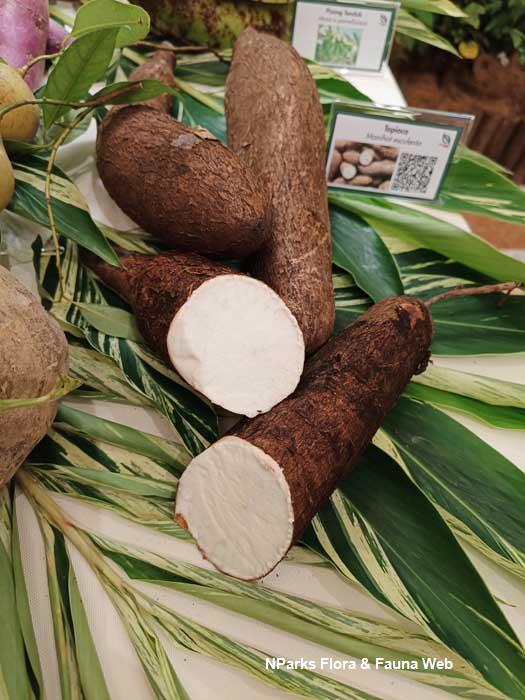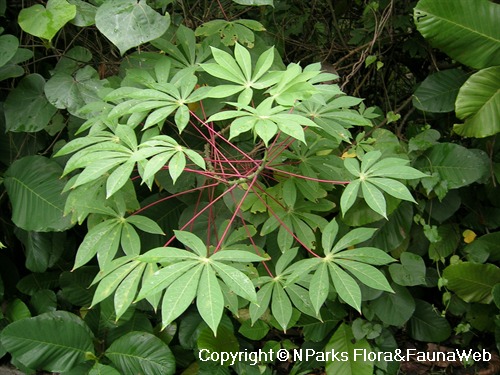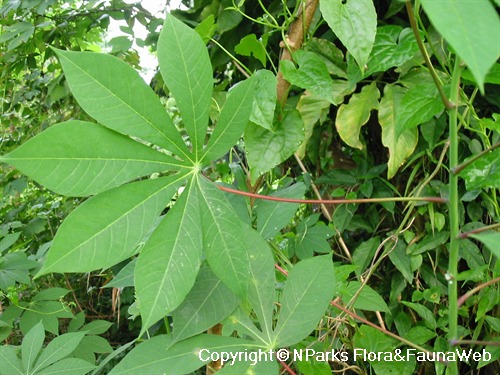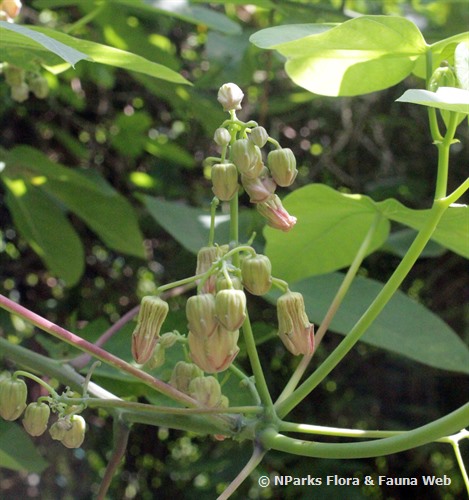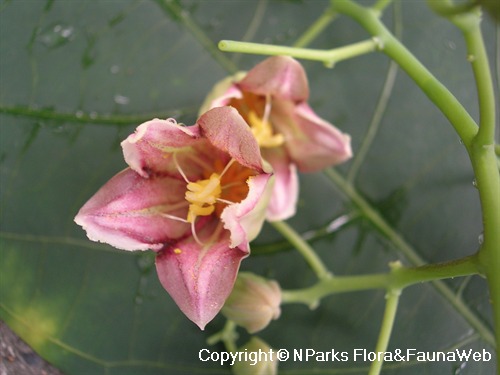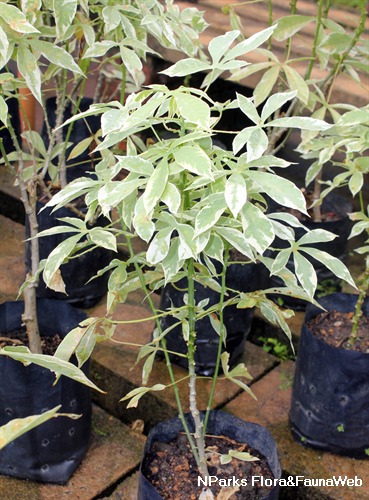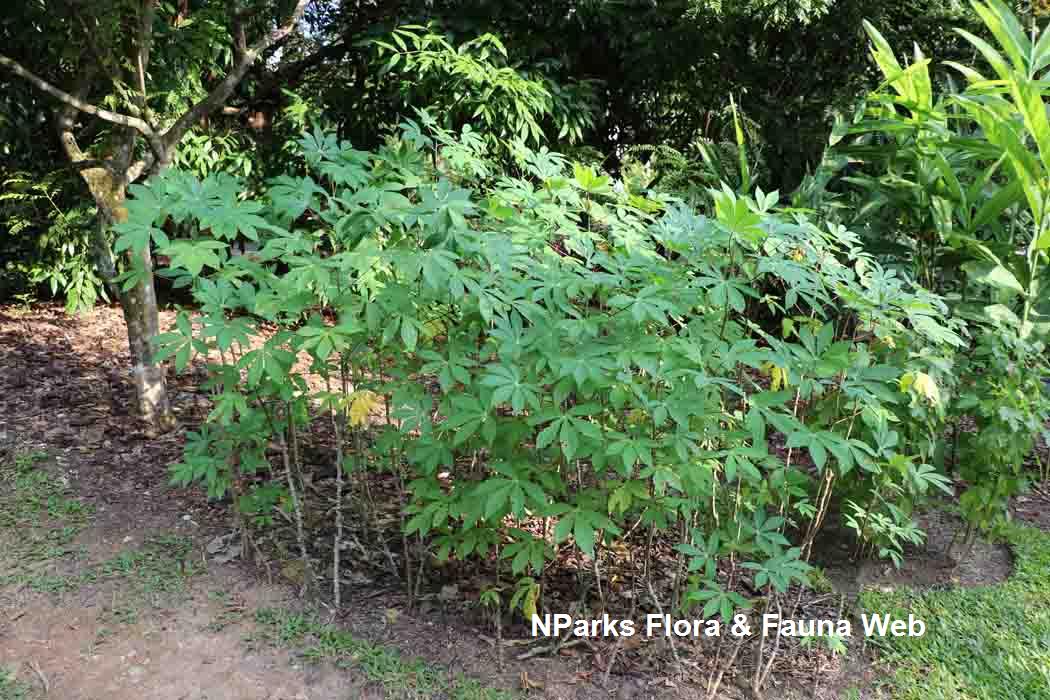
Back
Manihot esculenta Crantz
| Family Name: | Euphorbiaceae |
| Synonyms: | Jatropha manihot, Manihot aipi, Manihot manihot, Janipha manihot, Manihot utilissima |
| Common Name: | Tapioca, Ubi Kayu, Bitter Cassava, Manihot, Singkong, Manioc, Mandioca, Gari, 木薯 |
Tapioca (Manihot esculenta) is a bushy shrub with tuberous roots and palmate-lobed leaves. It is recognized as a dietary staple food worldwide.
Name
Classifications and Characteristics
| Plant Division | Angiosperms (Flowering Seed Plants) (Dicotyledon) |
|---|---|
| Plant Growth Form | Shrub |
| Lifespan (in Singapore) | Perennial |
| Mode of Nutrition | Autotrophic |
| Maximum Height | 2 m to 4 m |
Biogeography
| Native Distribution | Bolivia, Brazil, Colombia, Ecuador and Peru. |
|---|---|
| Native Habitat | Terrestrial (Agricultural Land, Disturbed Area / Open Ground) |
| Preferred Climate Zone | Tropical |
| Local Conservation Status | Non-native (Spontaneous (Naturalised)) |
Description and Ethnobotany
| Growth Form | Semi-woody perennial shrub with large tuberous roots, able to grow up to 4 m tall, has white latex. |
|---|---|
| Roots | Large tuberous roots |
| Foliage | Large dark green leaves measuring about 30 cm long, palmately divided into 5 - 9 lobes, spirally arranged, petioles are green or red and measuring up to 5 - 30 cm long. Stipules present, margin entire. |
| Stems | Woody, brownish or greyish, usually has prominent leaf scars. |
| Flowers | Inconspicuous flowers in a lax terminal raceme, measuring 3 - 10 cm long. Flower is unisexual, 5 united sepals and no petals. |
| Fruit | Fruit is a globose capsule, measuring 1 - 1.5 cm in diameter, smooth, has 6 longitudinal wings and contains 3 ellipsoidal seeds. |
| Cultivation | This species is grown via stem cutting, easy-to-grow and tolerant of most soil types including acidic and alkaline soils. Use stem cuttings of at least 30 cm long. Although it is drought tolerant, plant requires sufficient watering during earlier stage before established. Optimal growth occurs in moist, but well-drained sandy loam soils. Plant can be grown for roots or leaves. Generally, if plant is grown specifically for roots, the first harvest can be 6-7 months after planting. Once harvested, roots should be consumed or processed within 48 hours from harvesting <5>. Physiological changes cause blue or brown vascular streaks on roots, 2 days after harvest. If leaves are harvested from plant intended for root production, there will be reduction in root yield. If plant is grown specifically for leaves, the first harvest of leaves can be 50 - 70 days after planting. |
| Etymology | Genus Manihot is from the Tupi-Guarani name "manioca" which means cassava. Species esculenta means edible by humans. |
| Ethnobotanical Uses | Edible Plant Parts : Edible Leaves, Edible Roots Food (Fruit or Vegetable): The storage roots are one of the most important food crops grown in the tropics. They are a rich source of carbohydrates (25 - 30% starch), but low in protein. For human consumption, the storage roots are peeled and chopped and then boiled, steamed, fried or roasted, directly or after drying or fermenting. The outer purple layer must be completely peeled away, because they contain toxic hydrocyanoic glycosides. The roots of bitter cultivars need to be boiled at least twice, changing the water in between. The water used to boil the roots should not be consumed. Juice extracted from boiled roots is fermented into an alcoholic beverage known as Kasiri. Young leaves are edible after boiling and high in vitamins A and C. Medicinal: Scientific Evidence of Medicinal Properties Based on clinical trials on the effect of Tapioca on animals, it has these medicinal properties: antidiarrhea <2>, anti-inflammatory <1> and antioxidant <3>.
Traditional Medicinal Uses Native Americans use juice extracted from boiled roots as a treatment for burns. In Indochina, the starchy roots are used to dress ulcerous sores. In Indonesia, together with other plants, they are used to treat pains in the body. In Philippines, the bark is considered antirheumatic.
It is important to note that some therapeutic effects from traditional medicinal uses of plants are not currently supported or verified by scientific research. Others: The tapioca roots can be stored as flour and used for desserts or thickener in soups and stews. |
Landscaping Features
| Landscaping | This species can be grown for its ornamental foliage. The large, palmately compound leaves mounted on long petioles give the plant a graceful, elegant look. This species is attractive when planted in small groups. |
|---|---|
| Desirable Plant Features | Ornamental Foliage |
| Landscape Uses | Parks & Gardens |
| Thematic Landscaping | Economic Garden |
Fauna, Pollination and Dispersal
| Pollination Method(s) | Abiotic (Self-Pollinated) |
|---|
Plant Care and Propagation
| Light Preference | Full Sun |
|---|---|
| Water Preference | Moderate Water |
| Plant Growth Rate | Fast to Moderate |
| Rootzone Tolerance | Drought Tolerant |
| Planting Remarks | The most suitable parts of cuttings are preferably from the middle stem of plants grown at least 6-8 months old. Plant cuttings at a slanted angle (40 - 45 degrees) with most part of the cutting covered in soil, leaving about 10 cm long above ground. |
| Potential Problems | Whiteflies. |
| Pest(s) | Sucking Insects |
| Propagation Method | Stem Cutting (Semi-Hardwood) |
| Planting Distance | 1 m |
Foliar
| Foliage Retention | Evergreen |
|---|---|
| Mature Foliage Colour(s) | Green |
| Prominent Young Flush Colour(s) | Green |
| Foliar Type | Simple / Unifoliate |
| Foliar Arrangement Along Stem | Spiral |
| Foliar Attachment to Stem | Petiolate |
| Foliar Shape(s) | Non-Palm Foliage (Palmate) |
| Foliar Venation | Palmate |
| Foliar Margin | Entire |
| Foliar Apex - Tip | Acute |
| Leaf Area Index (LAI) for Green Plot Ratio | 4.5 (Shrub & Groundcover - Dicot) |
Non - Foliar and Storage
| Stem Type & Modification | Woody |
|---|---|
| Root Type | Underground |
| Specialised Storage Organ(s) | Underground (Root Tuber) |
Floral (Angiosperm)
| Flower & Plant Sexuality | Unisexual Flowers |
| Flower Colour(s) | Purple |
|---|---|
| Flower Grouping | Cluster / Inflorescence |
| Flower Location | Terminal |
| Flower Symmetry | Radial |
| Individual Flower Shape | Stellate / Star-shaped |
| Inflorescence Type | Raceme |
| Flowering Period | Free-Flowering |
| Flowering Habit | Polycarpic |
References
| References | <1> Amado-Cornejo et al. (2020). Anti-inflammatory activity of the ethnolic extract of the leaves of Manihot esculenta Crantz (Yuca) in an experimental model of acute inflammation. Rev. Fac. Med. Hum. Enero 20(1):94-98. <2> Bahekar, S.E., Kale, R.S. (2015). Antidiarrheal activity of ethanolic extract of Manihot esculenta Crantz leaves in wistar rats. J Ayurveda Integr Med. 6(1):35-40. <3> Bahekar, S.E., Kale, R.S. (2016). Evaluation of antioxidant activity of Manihot esculenta Crantz in wistar rats. Journal of Pharmacy and Bioallied Sciences 8(2):119-123. <4> Manihot esculenta Crantz, Missouri Botanical Garden Plant Finder, http://www.missouribotanicalgarden.org/plantfindersearch.aspx, Accessed October 17, 2022. <5> Pendak, Y., Osman, J., Gumbek, M. & Eng, L. Sarawak Department of Agriculture: Penanaman Ubi Kayu, https://doa.sarawak.gov.my/web/attachment/show/?docid=TmJyeTZCQUtQZjFoZ1dzTTQraHI3QT09OjowVm0giYhJQbU7vO3Kv5kY, Accessed June 6, 2024. <6> Veltkamp, H.J., de Bruijn, G.H. (1996). Manihot esculenta Crantz. In: Flach, M. & Rumawas, F. (Editors): Plant Resources of South-East Asia No 9: Plants yielding non-seed carbohydrates. PROSEA Foundation, Bogor, Indonesia. Database record: prota4u.org/prosea
|
|---|
Image Repository
Others
| Master ID | 916 |
|---|---|
| Species ID | 2210 |
| Flora Disclaimer | The information in this website has been compiled from reliable sources, such as reference works on medicinal plants. It is not a substitute for medical advice or treatment and NParks does not purport to provide any medical advice. Readers should always consult his/her physician before using or consuming a plant for medicinal purposes. |



